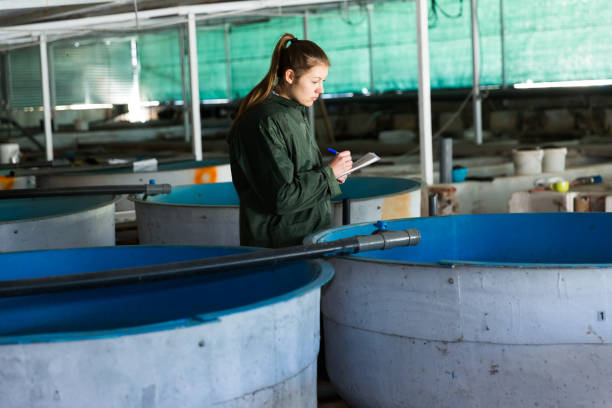Microbial additives used in aquaculture
The use of high-quality fish feeds is critical for the intensification of aquaculture. However, the cost of nutrition accounts for most of the production cost, directly affecting the industry’s efficiency. Moreover, using several raw materials for fish feed can degrade coastal ecosystems and wild fish stocks. Therefore, unconventional feed additives are emerging as an integral part of aquafeeds that will contribute to the sector’s sustainability.
Microbial additives belong in this category of alternative sustainable feed components.
What are microbial additives, and why have they gained popularity and importance in recent years?
According to the European Food Safety Authority’s (EFSA) guidance, microbial additives include bacteria, yeasts, and filamentous fungi used as feed ingredients (Rychen et al., 2018). Microbes and microbial-derived products, such as pigments and enzymes, can be produced sustainably, enhancing fish health and performance. Apart from that, they are considered environmentally friendly solutions since microorganisms can be produced in several substrates, including industrial wastes and agricultural byproducts (Gamboa-Delgado & Márquez-Reyes, 2016; Pailliè-Jiménez et al., 2020).
What are the beneficial effects of microbial additives in fish feed?
Protein Source in Fish Feed: Microbial Additives
As far as the potential benefits are concerned, their use as a protein source is worth mentioning. Traditionally, fishmeal has been used as the primary protein ingredient in aquaculture due to its high content of crude protein and essential amino acids. Microbes are also known for their high protein content; thus, they can constitute a sustainable alternative. Single-cell protein (SCP) is used for protein isolation. SCP can be purified proteins or consist of dried cell biomass (Bratosin et al., 2021). Bacterial SCP strains can produce up to 80% of SPC dry-weight (García-Garibay et al., 2003). Many studies have explored the potential use of SPC in finfish aquaculture using species like Saccharomyces, Candida, Kluyveromyces, and Wickerhamomyces. Also, several studies using yeast SCP in shrimp feeds highlighted its benefits on the growth of the reared species (Glencross et al., 2020).
Disease Management in Aquaculture: Probiotics and Prebiotics
Addressing diseases is a significant challenge in aquaculture, requiring effective management methods. The need to reduce the environmental impact of aquaculture demands sustainable solutions to control infections. The use of probiotics or prebiotics falls into this category of alternative solutions. Various publications exist using brewer’s yeast (Saccharomyces cerevisiae) as a probiotic for commercial species like Nile Tilapia (Oreochromis niloticus), rainbow trout (Oncorhynchus mykiss), gilthead seabream (Sparus aurata) to enhance health. In addition, components of the S. cerevisiae cell wall, which is composed mainly of polysaccharides (mannan oligosaccharides, β-glucans, chitin), have also been researched for their prebiotic use for benefits such as growth stimulation of bacterial species in the digestive tract or modulation of the innate immune system of the aquaculture species (del Valle et al., 2023). Apart from yeasts, bacterial species have also been studied for their role as probiotics in aquaculture for improving growth performance, disease resistance, immunity, health status, intestinal epithelial barrier integrity, gut microbiome, and even water quality (El-Saadony et al., 2021). Probiotic bacteria used in aquaculture include genera of Bacillus, Lactobacillus, Enterococcus, and Carnobacterium (Van Doan et al., 2020).
Value of Metabolites: Pigmentation and beyond
As mentioned above, microbial additives can also be used for their valuable metabolites. In aquaculture, a well-known case is the one of red yeast Phaffia rhodozyma. The color of a fish fillet, especially of salmonid species, is crucial to consumers as it visually indicates freshness and quality, influencing their perception of taste and nutritional value. The pink color of the fillet is attributed to astaxanthin, a pigment that belongs to a group of chemicals called carotenoids. The yeast P. rhodozyma has been broadly used as a natural source of commercial astaxanthin (Kheirabadi et al., 2022). Its astaxanthin levels have been estimated to be up to 50 times higher than those found in crustacean meals, which are also used as a natural source of pigment in aquaculture (Johnson, 2003).
Meanwhile, carotenoids are reported to enhance the health status of aquatic animals; thus, it becomes clear that such microorganisms may offer combined effects that are not limited only to pigmentation. Other metabolites that are interesting for their potential use in the aquaculture sector are enzymes. Probiotic bacteria, such as Bacillus sp., produce many enzymes like amylase, protease, lipase, xylanase, and cellulase in higher concentrations than native bacteria. The use of enzymes is essential for the development of a sustainable aquaculture industry and is becoming an important part of the fish feed industry (Liang et al., 2022; Panigrahi & Azad, 2007).
In conclusion, microbial additives could offer a multifaceted approach to tackle the aquaculture industry’s challenges concerning feed cost and environmental impacts. Microorganisms in the form of cells or through their valuable metabolites present promising sustainable solutions for efficient and environmentally friendly aquafeeds.
Literature
Bratosin, B. C., Darjan, S., & Vodnar, D. C. (2021). Single-cell protein: A potential substitute in human and animal nutrition. In Sustainability (Switzerland) (Vol. 13, Issue 16). MDPI. https://doi.org/10.3390/su13169284
del Valle, J. C., Bonadero, M. C., & Fernández-Gimenez, A. V. (2023). Saccharomyces cerevisiae as probiotic, prebiotic, synbiotic, postbiotics and parabiotics in aquaculture: An overview. In Aquaculture (Vol. 569). Elsevier B.V. https://doi.org/10.1016/j.aquaculture.2023.739342
El-Saadony, M. T., Alagawany, M., Patra, A. K., Kar, I., Tiwari, R., Dawood, M. A. O., Dhama, K., & Abdel-Latif, H. M. R. (2021). The functionality of probiotics in aquaculture: An overview. In Fish and Shellfish Immunology (Vol. 117, pp. 36–52). Academic Press. https://doi.org/10.1016/j.fsi.2021.07.007
Gamboa-Delgado, J., & Márquez-Reyes, J. M. (2016). The potential of microbial-derived nutrients for aquaculture development. Reviews in Aquaculture, 10(1), 224–246. https://doi.org/10.1111/RAQ.12157
García-Garibay, M., Gómez-Ruiz, L., Cruz-Guerrero, A. E., & Bárzana, E. (2003). SINGLE-CELL PROTEIN | Algae. In Encyclopedia of Food Sciences and Nutrition (Second Edition). Academic Press.
Glencross, B. D., Huyben, D., & Schrama, J. W. (2020). The application of single-cell ingredients in aquaculture feeds—a review. In Fishes (Vol. 5, Issue 3, pp. 1–39). MDPI AG. https://doi.org/10.3390/fishes5030022
Johnson, E. A. (2003). Phaffia rhodozyma: Colorful odyssey. In International Microbiology (Vol. 6, Issue 3, pp. 169–174). Springer-Verlag GmbH Co. KG. https://doi.org/10.1007/s10123-003-0130-3
Kheirabadi, E. P., Shekarabi, P. H., Yadollahi, F., Soltani, M., Najafi, E., von Hellens, J., Flores, C. L., Salehi, K., & Faggio, C. (2022). Red yeast (Phaffia rhodozyma) and its effect on growth, antioxidant activity, and color pigmentation of rainbow trout (Oncorhynchus mykiss). Aquaculture Reports, 23. https://doi.org/10.1016/j.aqrep.2022.101082
Liang, Q., Yuan, M., Xu, L., Lio, E., Zhang, F., Mou, H., & Secundo, F. (2022). Application of enzymes as a feed additive in aquaculture. In Marine Life Science and Technology (Vol. 4, Issue 2, pp. 208–221). Springer. https://doi.org/10.1007/s42995-022-00128-z
Pailliè-Jiménez, M. E., Stincone, P., & Brandelli, A. (2020). Natural Pigments of Microbial Origin. In Frontiers in Sustainable Food Systems (Vol. 4). Frontiers Media S.A. https://doi.org/10.3389/fsufs.2020.590439
Panigrahi, A., & Azad, I. S. (2007). Microbial intervention for better fish health in aquaculture: The Indian scenario. Fish Physiology and Biochemistry, 33(4), 429–440. https://doi.org/10.1007/s10695-007-9160-7
Rychen, G., Aquilina, G., Azimonti, G., Bampidis, V., Bastos, M. de L., Bories, G., Chesson, A., Cocconcelli, P. S., Flachowsky, G., Gropp, J., Kolar, B., Kouba, M., López-Alonso, M., López Puente, S., Mantovani, A., Mayo, B., Ramos, F., Saarela, M., Villa, R. E., … Galobart, J. (2018). Guidance on the characterization of microorganisms used as feed additives or as production organisms. EFSA Journal, 16(3). https://doi.org/10.2903/j.efsa.2018.5206
Van Doan, H., Hoseinifar, S. H., Ringø, E., Ángeles Esteban, M., Dadar, M., Dawood, M. A. O., & Faggio, C. (2020). Host-Associated Probiotics: A Key Factor in Sustainable Aquaculture. In Reviews in Fisheries Science and Aquaculture (Vol. 28, Issue 1, pp. 16–42). Taylor and Francis Inc. https://doi.org/10.1080/23308249.2019.1643288










































































